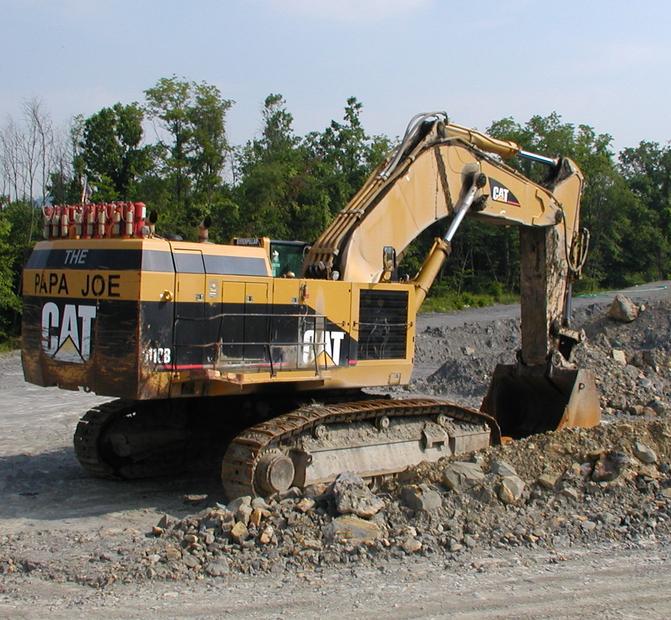
| Next Chapter | Previous Chapter | |
| Chapter 33: The Old Folks | Contents | Chapter 31: Changes in Strip Mining Techniques I |
By the time the coal was stripped on the Jesse Run farm about 1970, the big loaders described above
(Illustration 32-1)

The backhoe “Papa Joe” named for Joe Sutton, who founded United Coals, is located on their job at McWhorter
were a major earth and rock moving device. Moving the loaders from job to job was a problem, because it was illegal to put such wide and heavy machines on he road. However, Mr. White knew what the fines would be, and chose to take out a million dollars liability insurance for accidents for one day. Then late at night he would drive them from one job to another on the public roads. The more expensive alternative he rejected was to disassemble the loader and move the parts on heavy trucks.
The dozers had gotten larger, up to the D-9 size, but the tracks were still driven by a single large cogwheel in the rear, the same design all dozers had until that time. Mr. White had his own drilling and blasting crew, and the coal was hauled off the hill to a tipple near Weston in ten wheelers. The bench was restored to an approximate two percent grade, one of the last to be done this way. Unfortunately Mr. White’s operator could not resist the impulse to round off the outer edge in some places. Here again we had two benches, and it remains just as he left it to this day. Shortly after this, the Kolb place on Clay Lick next to ours was stripped by Grafton Coal, but the backfill had to be placed back against the high wall.
For the third and last time coal was removed from the Lost Creek farm by United Coals. By then, in the mid1990s, Ralph Sutton and his brother Butch ran the only stripping company around. Their father had gotten a start with Costelac, on Duck Creek, where they had mined a lot of coal that had previously been deep mined. Costelac removed the overburden with a huge dragline, a type of earthmover related to the steam shovel that had a long boom set at a low angle which carried a bucket away from the cab and engine, then dragged it back filling with dirt, by a second cable. The machine picked this up, rotated and dropped the refuse out of the way a boom’s length away. Then the rock and dirt were taken out of the old mine shafts with light equipment. Finally the coal left by the deep mining was removed. The concept is simple, but the trick to doing this is to keep the cost low enough to be competitive.
By the time the Suttons stripped at Lost Creek, the backfilling law required the rock and dirt be placed against the high wall, all the way up to the top. This in turn dictated that when an area was mined, the
(Illustration 32-2)
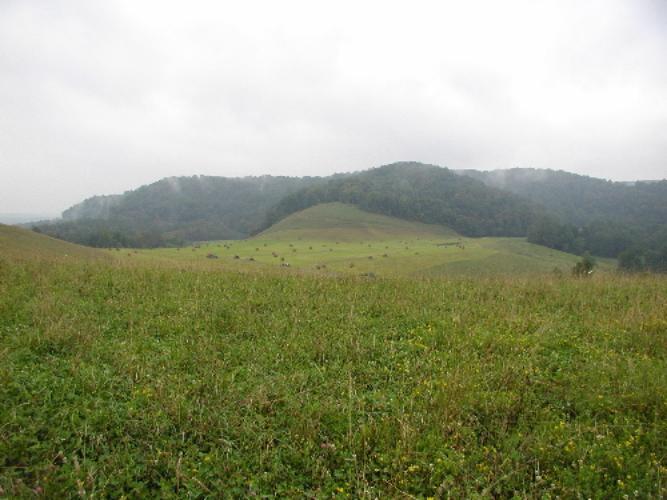
This reclaimed strip mine won a national competition
dirt would be used to refill the previously mined area. In the previous method the dirt mostly moved to a lower elevation from where it was originally. Now some dirt went downhill a little, but most was essentially moved horizontally and uphill. Bulldozers are much less efficient at moving dirt up hill, so larger and more powerful ones were used. The D-11 Caterpillar dozers used on this job had a 750 horsepower engine (real horsepower, not the inflated figures used for passenger cars and trucks). These machines used about 500 gallons of diesel fuel per shift. The driving wheel was high up under the cab, a third wheel with cogs in the track, a new configuration in bulldozers.
To get the overburden all the way to the top of the highwall huge off-the-road trucks were used. They
(Illustration 32-3)
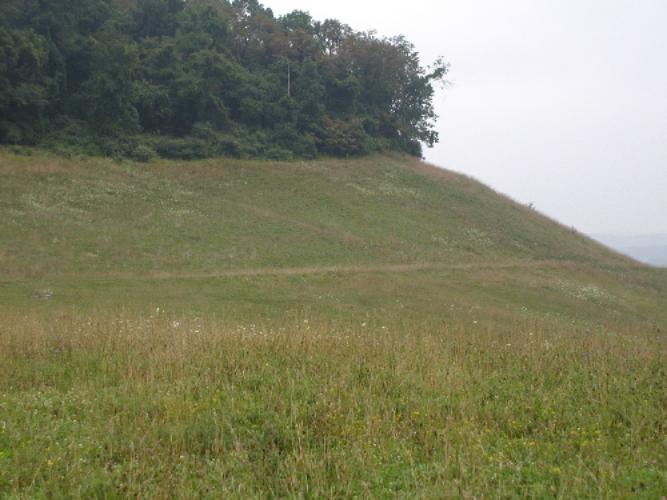
Reclaimed strip mine 2
were six wheel affairs, with tires taller than a man. They were much too large to go on the road but were more efficient at elevating the material that had to go to the top of the high wall.
One effect of the placement of spoil high up against the highwall was to vastly increase the amount of fuel needed to strip mine. This new requirement came somewhat before the consideration of energy expenditure became important. With the oil situation becoming more important each year, this change might not have been so wise as some thought. I have read the energy derived from the coal mined by stripping requires about one-third as much energy input in the form of petroleum products. But the money is right, and we must have our energy.
(Illustration 32-4)
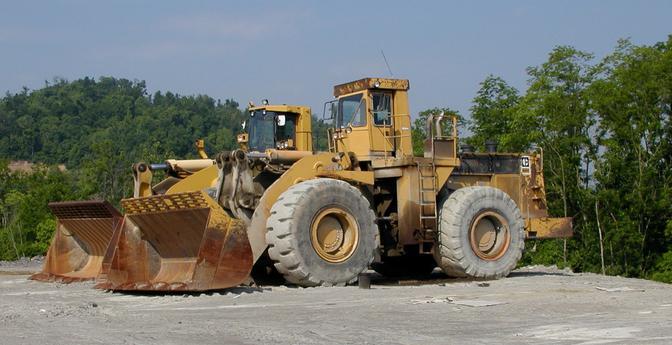
Large front loaders on the United Coals strip mine
These large trucks used to haul spoil uphill were loaded by equally large backhoes, similar in configuration to the old steam shovels, but which picked up their load by pulling the bucket toward the cab and engine. They were operated by hydraulics, whereas the steam shovels used cables that ran over pulleys and were wound on a drum. The old steam shovels had a trap door in the bottom of the bucket with a latch. The bucket would be extended over a truck bed, the latch pulled, and the contents would drop in the truck bed. With backhoes the bucket would be extended over the truck and hydraulics would tilt it and dirt would come out of the bucket the way it went in.
The big back hoes were used to remove debris from the WWI mine tunnels, or “headers” after the overburden was removed. Finally, the coal would be “shot” with explosive and loaded with the backhoe. The trucks that hauled coal over the roads now had fourteen wheels. Trailer trucks could carry more coal than the fourteen wheel trucks, but could not be moved around in the mine pit as well.
(Illustration 32-5)
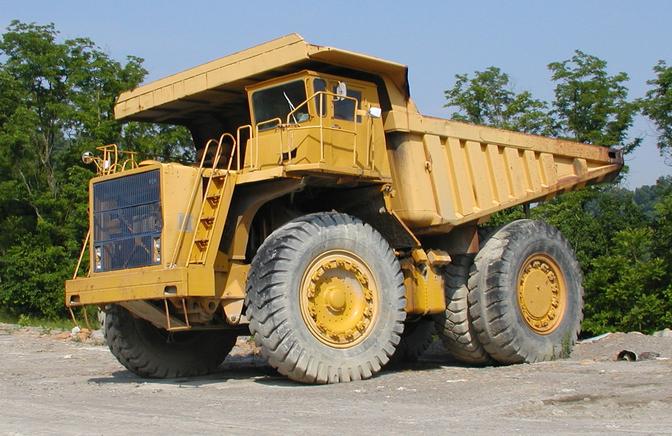
Off road truck on the United Coals strip mine
You would see eighteen wheel and even twenty two wheel coal trucks on the road, but you knew they were loaded by a conveyor, the truck inching past the stream of coal provided by the conveyor. There was a coal cleaning plant at the head of Jesse Run at the time, run by Roblee Coal Company. It was hauled up the run in these trailer trucks, cleaned, and hauled back down Jesse Run. The material cleaned out of the coal was made into a kind of mortar with quick lime, and will be there forever, I suppose. At least I hope it will. The most likely way it would be removed by nature is for the mortar-like material to break up and be washed down the run in lumps, or to dissolve over time and come out in solution.
The arrangement for “shooting” or blasting the overburden and coal had come to another phase, too. A heavy blast is capable of damaging wells and springs, and the accusation of such damage has often been made unfairly. And there are a lot of other hazards to blasting. United Coals, which did the mining, hired a company which manufactured explosives to do all the steps. First they took a survey with well samples from the area around the site. Then they provided a man trained to locate the holes where the explosive would be emplaced, someone who could use a mathematical formula to take into consideration the type of rock, the depth to which the blast was to break the rock up, the lateral expanse of the shot, terrain, etc. Ralph’s man would then bore the holes. The explosive company man would load the holes with the proper amount of explosive, now a granular material, connect the blasting caps, hook up the wire and complying with the laws and at a convenient time, set off the explosive. The explosive company even carried the insurance in case anything went wrong.
The same back hoe used to clean out the horizontal mine shafts left over from the WWI mining was used to load the trucks which took the coal directly to the power plant. The fourteen wheel trucks were called “triaxles.” A few even had an additional axle, usually with only two tires, in front of the rear wheels which could be let down with hydraulics to make another load bearing axle. They could be raised on the return trip to reduce the wear on the steering wheels in front. The evolution of the number of wheels on coal trucks was due to the fact that labor was one of the larger expenses in hauling coal, and thus there was economic pressure to make the loads larger, so not so many trips would have to be made. The law specified the maximum number of tons that could be placed on an axle. Therefore, more axles allowed more load. About the time this was written the legislature caved in to the mining interests
(Illustration 32-6)
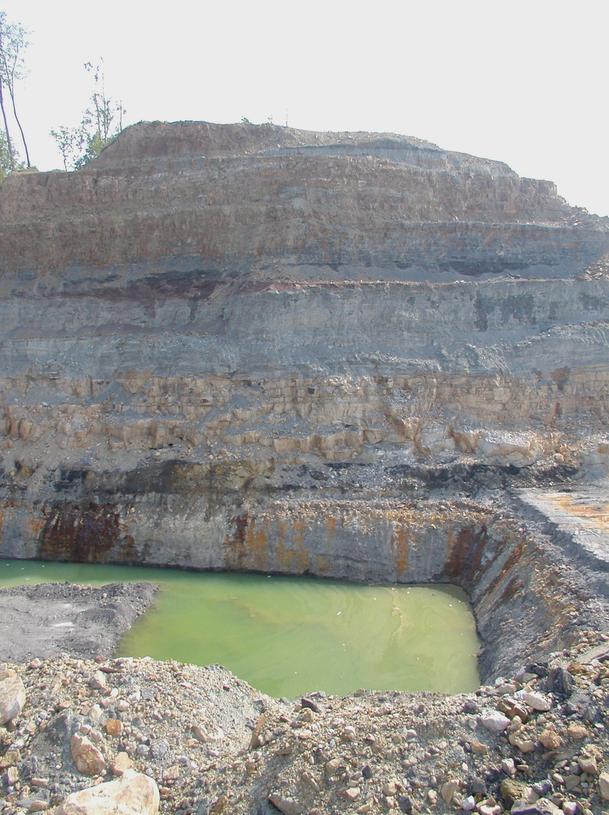
Mining pit. Notice the many layers of “overburden.” Coal came from the level of the water at the bottom. This will be refilled, graded to contour, and the new surface will be fertilized and sown with grass. This is where your electricity comes from, folks!
and allowed over weight trucks on certain roads. You just have to shake your head in disbelief.
In the early days trucks were loaded until the coal fell off on all sides. You could walk all the way from Lost Creek to West Milford on the coal spilled off trucks. Some places it got a foot deep and on the weekends poor people would gather their winter coal along the road. You could imagine how this affected the vegetation along the road.
(Illustration 32-7)
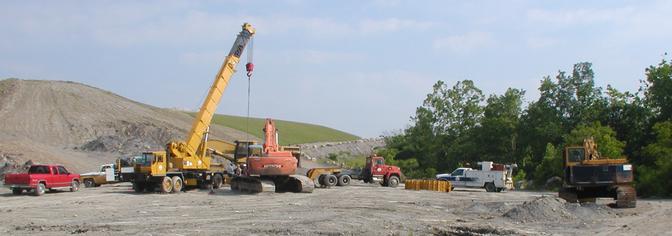
Assembling a large backhoe transported over the road. Moving heavy equipment is very expensive.
Somewhere in the era of ten and fourteen wheelers, laws were passed against spilling coal, but the cop had to be there to see it, so the laws weren’t very effective. Later there was a law passed that the coal had to be covered. Trucks had a tarpaulin on arms that rolled up to expose the empty bed, and then could be moved back to cover up the load when it was being transported. Now sometimes you see coal trucks with the load uncovered, but the bed is large enough so that the coal is six inches to a foot below the rim. At long last the State had gotten serious about spilled coal.
Back to the final removal of coal from the Lost Creek farm. After the spoil was put back, seeding was done with a machine that took in bales of hay, cut it into two inch straws, mixed it with a little water, fertilizer, seed and a green dye. This was sprayed on the bare ground with a blast of air out of a gun that was about a foot in diameter. The dye was to help the operator to see where he had sprayed the mixture.
(Illustration 32-8)
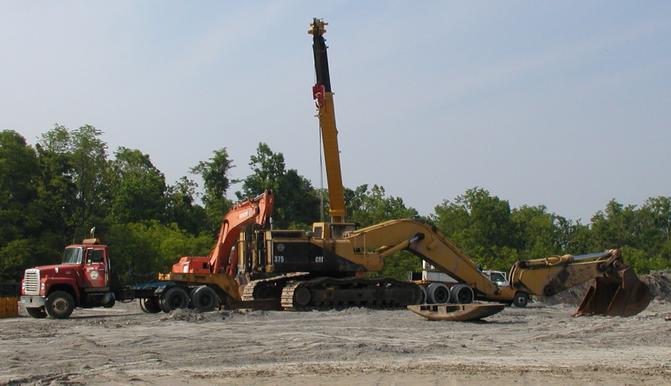
Backside of the previous picture, closer up. The new backhoe lacks the bucket and the end of the arm that attaches to it, which was a truckload. The rounded piece in the foreground is a weight that also serves as a bumper on the back of the cab.
In the level bench method that was used by strip miners for putting the spoil back in the early days there were areas with very little slope, and this resulted in useful land for farming and development. With the present method of back filling there are a lot of slopes that are so steep and long that they rut badly, preventing access with machinery. The good intentions of the environmentalists, who wanted to see the hills back to the same shape, resulted in less agricultural land than a more thoughtful policy would have and much more fuel being used. It reduced the sediment in the streams draining the area, at least soon after the stripping, however.
Aside A habit of many of my fellow West Virginians I detest is throwing bottles, cans and papers from fast food stores out the window of a moving car (or where ever they are) when through with them. It results in a tremendous increase in entropy – disorder. It is much more difficult to pick it all up (in fact, it never is all picked up) than it is to throw it out. So much would be saved if people would put it in a plastic bag in their vehicle and carry it home. I find trash on the hill, half a mile from the road, in the barn at Lost Creek from trespassers, even in the hay, everywhere.
A few years ago there was a very strong movement to curtail this problem by putting a return deposit on bottles and cans. It was fought by the unions that make bottles and cans and the company owners. The now defunct Weston Independent and the Weston Democrat, which survives, both fought for the return deposit.
| Next Chapter | Previous Chapter | |
| Chapter 33: The Old Folks | Contents | Chapter 31: Changes in Strip Mining Techniques I |
Copyright © 1998, 2006, 2008, 2011 S. Tom Bond (stombond at hughes.net)